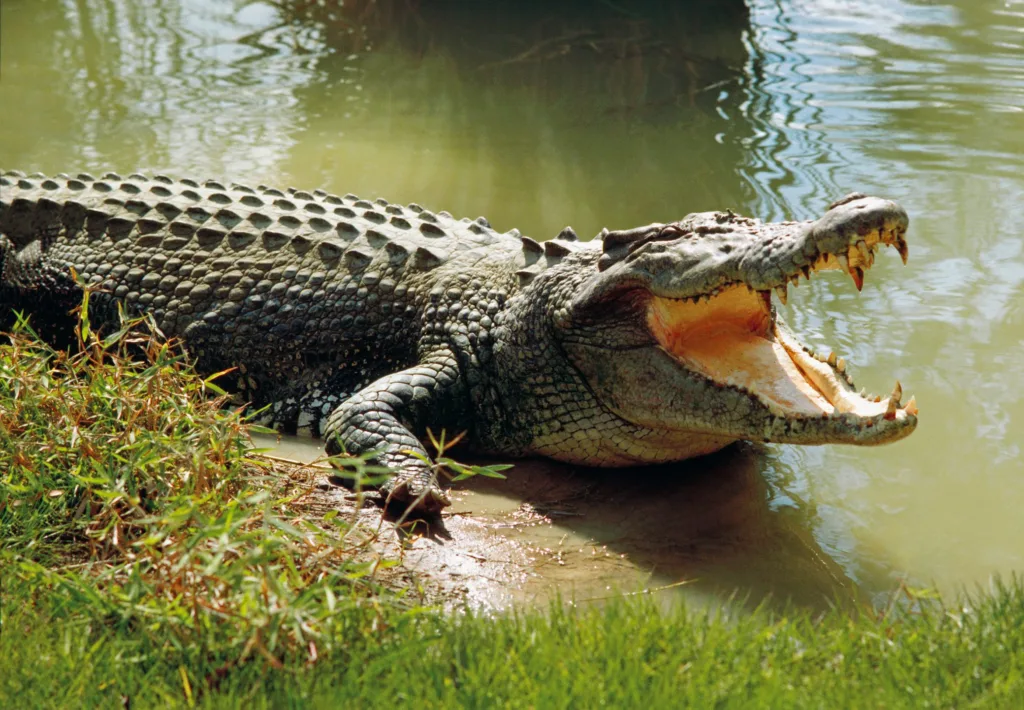
1. The largest reptiles on Earth are crocodiles.
2. The strongest bite in the animal kingdom belongs to crocodiles.
The maximum pressure that a human jaw can exert per square inch is only 100 pounds. In contrast, according to our knowledge of crocodiles, their jaws can exert 5000 pounds of pressure per square inch. In comparison to a great white shark, it has a bite that is ten times more potent. However, despite this, the crocodiles’ jaw-opening muscles are so tiny and feeble that a person may seal their mouth with simply a rubber band or his or her hands.
3. Crocodiles can swim quite well.
Crocodiles move quite quickly through the water. They have a maximum swimming speed of 22 mph, or 35 km/h. They move across the water by using their muscular tails and their webbed feet as rudders. Additionally, their tails enable them to remain upright in the water for up to three hours.
4. They frequently have their lips open when sleeping.
If you see a crocodile with its mouth open, do not become alarmed. When they witness a crocodile emerge from the water with its mouth open, the majority of people immediately think that they are in danger. But in truth, they just “mouth gape,” or open their lips, to let off steam. Since crocodiles cannot perspire, they will sit or lie down with their mouths open to let heat escape. Although it may appear threatening, they are not acting aggressively.
5. The tiniest crocodile in the world is found in West Africa. reaching a height of 1.8 meters (5.9 feet). In tunnels in the hollows of low-lying tree branches along the water’s edge, it can be found alone or in couples.
6. The largest reptiles in the world are saltwater crocodiles. They may reach a height of 7.0 meters (23 feet) and weigh between 2200 and 2600 pounds.
7. To aid with digestion, they ingest tiny stones.
Animals with shells and bones or crocodiles that consume their prey whole benefit from swallowing stones called “gastroliths.” Food is ground in their stomachs with the aid of gastroliths. The crocodile’s stomach may harbor these stones for many years.
8. They have 24 teeth, but they seldom chew anything with them since they are so sharp.
serpentine teeth
Crocodiles have 24 very sharp teeth, yet they hardly ever utilize them to eat their meal. Instead, they seize, grasp, and smash their prey or food using their teeth. Small stones that they ingest ground-up food for in their stomachs. Additionally, when they close, their jaws may apply a significant amount of force, yet little is required to hold them shut.
9. The heart of a crocodile contains four chambers.
The majority of bird species are similar to it, and while it is on dry land, it will act like other animals. However, the crocodile’s heart operates like a three-chambered organ while it is swimming, leaping, or diving. They can spend more time underwater because of this, much like other reptiles can.
10. A crocodile egg’s temperature can reveal the gender of the embryo.
A male crocodile will hatch if the egg inside reaches a temperature of 88.8 degrees Fahrenheit. A female crocodile will hatch if the temperature is either above or below this level.
11. There are 23 different species of crocodiles in the world, and each has a different lifetime of between 35 and 75 years.
12. They always have powerful, long tails. When swimming and moving on land, they help crocodiles maintain equilibrium. Males may utilize them during courting to attract attention. They may flick their tail during assaults to knock their prey unconscious.
13. Crocodiles swim far faster than they can walk.
There is a common misconception that crocodiles cannot be outrun because of their speed. While the typical person can sprint eight to nine miles per hour and crocodiles can belly run up to 11 miles per hour, when your adrenaline begins pounding, you should be able to outrun a crocodile since they fatigue quickly.
14. Morelet’s crocodile
The modestly sized Morelet’s crocodile (Crocodylus moreletii), commonly referred to as the Mexican or Belize crocodile, is a freshwater crocodilian that is exclusively found in the Atlantic areas of Mexico, Belize, and Guatemala.[ It often reaches a length of 3 meters (10 feet). It is a species of Least Concern. Guatemala contains a fossil record of the species.
15. The saltwater crocodile (Crocodylus porosus)
From the east coast of India to Southeast Asia and the Sundaic area to northern Australia and Micronesia, the saltwater crocodile (Crocodylus porosus) is a crocodilian that is indigenous to saltwater environments, brackish wetlands, and freshwater rivers. Since 1996, it has been categorized as Least Concern on the IUCN Red List. Its range was extensively hunted for its skin up until the 1970s, and it is now endangered due to unlawful hunting and habitat destruction. It is thought to be harmful to people.
watch our other post